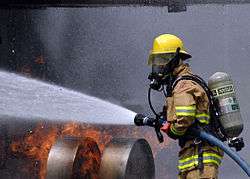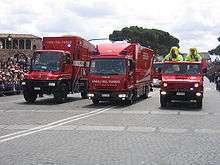Firefighter
|
A U.S. Navy firefighter douses a fire during a training drill in July 2008. He is equipped with a fire hose with fog nozzle, breathing apparatus, helmet and full structural firefighting kit. | |
| Occupation | |
|---|---|
Activity sectors | Rescue, fire protection, civil service, public service, public safety, |
A firefighter (historically fireman) is a rescuer extensively trained in firefighting, primarily to extinguish hazardous fires that threaten property and civilian or natural populations, and to rescue people from dangerous situations, like collapsed or burning buildings or crashed vehicles. In some areas, they are also trained in Emergency Medical Services (EMS) and operate ambulances in addition to being a firefighter.
The complexity of modern industrialized life with a greater prominence of hazards has created an increase in the skills needed in firefighting technology and a broadening of the firefighter-rescuer's remit. The fire service, or fire and rescue service, also known in some countries as the fire brigade or fire department, is one of the three main emergency services. Firefighting and firefighters have become ubiquitous around the world, from wildlands to urban areas, and aboard ships. According to Merriam-Webster's Dictionary, the English word firefighter has been used since 1903.[1] In recent decades it has become the preferred term, replacing fireman, since women also serve as firefighters, and also because the term fireman can have other meanings, including someone who sets, stokes, or tends fires, especially in designated fireplaces – the opposite of the firefighting role.[2]
In many countries, while most firefighters are volunteers, firefighters may also be employed as full-time workers and paid a salary. Volunteer firefighters (who are theoretically unpaid) and retained firefighters (or auxiliary firefighters, who are paid for the specific time they are on duty, i.e., permanent part-time career firefighters) on call as required.[3] In such countries as the United Kingdom, the use of additional retained firefighters is standard. In Portugal, for example, the use of volunteer firefighters is standard, along with career firefighters. In Australia there are volunteer brigades which are mostly unpaid rural services, although traditionally they are paid by their employers if called out during usual working hours.
Goals of firefighting
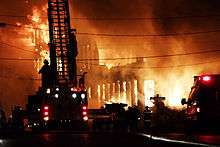
The goals of firefighting are (in order of priority): As such, the skills required for safe operations are regularly practiced during training evaluations throughout a firefighter's career. In the United States, the preeminent fire training and standards organization is the National Fire Protection Association (NFPA). Often initial firefighting skills are taught during a local, regional, or state approved fire academy.[4] Depending on the requirements of a department, additional skills and certifications such as technical rescue and Para-medicine may also be taught at this time.
Firefighters work closely with other emergency response agencies, most particularly local and state police departments. As every fire scene is technically a crime scene until deemed otherwise (depending on the area) by a Fire Chief, a Police Department, or qualified investigator, there is often overlap between the responsibilities of responding firefighters and police officers such as evidence and scene protection, initial observations of first respondents, and chain of evidence issues. The increasing role of firefighters in providing emergency medical services also brings firefighters into common overlap with law enforcement. One example of this is a common state law requiring all gunshot wounds to be reported to law enforcement agencies.
Fire fighting has some basic skills: prevention, self-preservation, rescue, preservation of property, basic first aid, and fire control. Firefighting is further broken down into skills which include size-up, extinguishing, ventilation, salvage and overhaul. Wildland firefighting includes size up, containment, extinguishment, and mop up. Search and Rescue, which has already been mentioned, is performed early in any fire scenario and many times is in unison with extinguishing and ventilation.
Prevention

Fire suppression systems have a proven record for controlling and extinguishing unwanted fires. Many fire officials recommend that every building, including residences, have fire sprinkler systems. Correctly working sprinklers in a residence greatly reduce the risk of death from a fire. With the small rooms typical of a residence, one or two sprinklers can cover most rooms.
In addition, a major duty of fire services is the regular inspection of buildings to ensure they are up to the current building fire codes, which are enforced so that a building can sufficiently resist fire spread, potential hazards are located, and to ensure that occupants can be safely evacuated, commensurate with the risks involved.
Other methods of fire prevention are by directing efforts to reduce known hazardous conditions or by preventing dangerous acts before tragedy strikes. This is normally accomplished in many innovative ways such as conducting presentations, distributing safety brochures, providing news articles, writing public safety announcements (PSA) or establishing meaningful displays in well-visited areas. Ensuring that each household has working smoke alarms, is educated in the proper techniques of fire safety, has an evacuation route and rendezvous point is of top priority in public education for most fire prevention teams in almost all fire department localities.
Self-preservation
Tools are generally carried at all times and are important for not only forcible entry but also for self-rescue. A self-contained breathing apparatus (SCBA) delivers air to the firefighter through a full face mask and is worn to protect against smoke inhalation, toxic fumes, and super heated gases. A special device called a Personal Alert Safety System (PASS) is commonly worn independently or as a part of the SCBA to alert others when a firefighter stops moving for a specified period of time or manually operates the device. The PASS device sounds an alarm that can assist another firefighter (Firefighter Assist and Search Team (FAST), or Rapid Intervention Team (RIT)), in locating the firefighter in distress.
Firefighters often carry personal self-rescue ropes. The ropes are generally 30 feet long and can provide a firefighter (that has enough time to deploy the rope) a partially controlled exit out of an elevated window. Lack of a personal rescue rope is cited in the deaths of two New York City Firefighters, Lt. John Bellew and Lt. Curtis Meyran, who died after they jumped from the fourth floor of a burning apartment building in the Bronx. Of the four firefighters who jumped and survived, only one of them had a self-rescue rope. Since the incident, the Fire Department of New York City has issued self-rescue ropes to their firefighters.
In the United States, 25% of fatalities of firefighters are caused by vehicle accidents while responding to or returning from an incident. Many firefighters are also injured or killed by vehicles while working at an incident (Paulison 2005). Recently (November 24, 2008) a new measure was established by many departments that requires firefighters to wear a bright yellow reflective vest over their turnout coats while working on the scene of vehicle accidents. The advent of this measure was implemented so firefighters are more visible to the other drivers on the road.[5] In addition to the direct dangers of firefighting, cardiovascular diseases account for approximately 45% of on duty firefighter deaths.[6]
Fire control
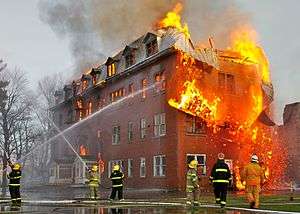
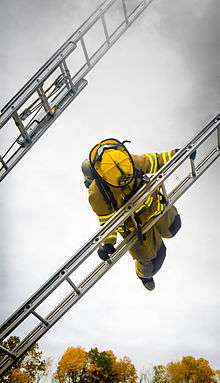
Fire control (or fire fighting) consists of depriving a fire of fuel (Reducing Agent), oxygen (Oxidizing Agent), heat and/or the chemical chain reaction that are necessary to sustain itself or re-kindle (also known as the four components of the fire tetrahedron). Firefighters are equipped with a wide variety of equipment to accomplish this task. Some of their tools include ladder trucks, pumper trucks, tanker trucks, fire hose, and fire extinguishers. Very frequent training and refresher training is required.
Structure fires may be attacked, generally, either by "interior" or "exterior" resources, or both. Interior crews, using the "two-in, two out" rule, may advance hose lines inside the building, find the fire and cool it with water. Exterior crews may direct water into windows or other openings, or against other nearby fuels exposed to the initial fire. Hose streams directed into the interior through exterior wall aperturtes may conflict with and jeopardize interior fire attack crews. A proper command structure will plan and coordinate the various teams and equipment to safely execute each tactic.
- See also Fire suppression for other techniques.
Structure fires
Buildings that are made of flammable materials such as wood are different from so called "fire-resistant" buildings such as concrete high-rises. Generally, a "fire-resistant" building is designed to limit fire to a small area or floor. Other floors can be safe simply by preventing smoke inhalation and damage. All buildings suspected of being on fire must be evacuated, regardless of fire rating.
While sometimes fires can be limited to small areas of a structure, wider collateral damage due to smoke, water, and burning embers is common. Utility shutoff (such as gas and electricity) is typically an early priority of arriving fire crews. Furthermore, fire prevention can take on a special meaning for property where hazardous materials are being used or stored.
Some fire fighting tactics may appear to be destructive, but often serve specific needs. For example, during "ventilation" firefighters are often forced to open holes in the roof or floors of a structure (called "vertical ventilation") or open windows or walls (called "horizontal ventilation") to remove smoke and heated gases from the interior of the structure. Such ventilation methods are also used to improve interior visibility facilitating locating victims more quickly. This also helps to preserve the life of trapped or unconscious individuals as it vents the poisonous gases from inside of the structure. Vertical ventilation is absolutely vital to firefighter safety in the event of a flashover or backdraft scenario. Releasing the flammable gasses through the roof often eliminates the possibility of a backdraft and by the removal of heat the possibility of a flashover is reduced significantly. Flashovers, due to their intense heat (900–1200° Fahrenheit) and explosive temperaments are almost always fatal to firefighter personnel. Precautionary methods, such as smashing a window, often reveal backdraft situations before the firefighter enters the structure and is met with the circumstance head-on. Firefighter safety is the number one priority.
Whenever possible, movable property is moved into the middle of a room and covered with a heavy cloth tarp (a "salvage cover"). Other steps may be taken to divert or remove fire flow runoff (thus salvaging property by avoiding unnecessary damage), retrieving/protecting valuables found during suppression or overhaul, and boarding windows, roofs.
HAZMAT
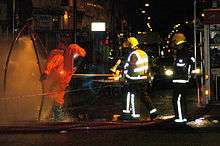
Firefighters in the United States are frequently the first responders to HAZMAT incidents. The Occupational Safety and Health Administration standard 1910.120[7] defines four standards of training First responder awareness level, First responder operations level, Hazardous materials technician, and Hazardous materials specialist. EMS-based paramedics are typically trained to the awareness level, whereas career and volunteer firefighters are often trained to the operations level or better. Other nations have trained only elite firefighters and rescuers to do HAZMAT so that funding and equipment could go to fewer stations. This gives departments elite HAZMAT personnel and high-grade equipment for an incident. Departments place these companies in stations where they can be very mobile.
Cardiovascular disease
Firefighting has long been associated with poor cardiovascular outcomes. In the United States, the most common cause of on-duty fatalities for firefighters is sudden cardiac death. In addition to personal factors that may predispose an individual to coronary artery disease or other cardiovascular diseases, occupational exposures can significantly increase a firefighter's risk. Historically, the fire service blamed poor firefighter physical condition for being the primary cause of cardiovascular related deaths. However, over the last 20 years, studies and research has indicated the toxic gasses put fire service personnel at significantly higher risk for cardiovascular related conditions and death. For instance, carbon monoxide, present in nearly all fire environments, and hydrogen cyanide, formed during the combustion of paper, cotton, plastics, and other substances containing carbon and nitrogen. The substances inside of materials change during combustion their bi-products interfere with the transport of oxygen in the body. Hypoxia can then lead to heart injury. In addition, chronic exposure to particulate matter in smoke is associated with atherosclerosis. Noise exposures may contribute to hypertension and possibly ischemic heart disease. Other factors associated with firefighting, such as stress, heat stress, and heavy physical exertion, also increase the risk of cardiovascular events.[8]
During fire suppression actives a firefighter can reach peak or near peak heart rates which can act as a trigger for a cardiac event. For example, tachycardia can cause a plaque build up to break loose and lodge itself is a small part of the heart causing myocardial infarction, also known as a heart attack. This along with unhealthy habits and lack of exercise can be very hazardous to firefighter health. [9]
Heat stress

Heat injury is a major issue for firefighters as they wear insulated clothing and cannot shed the heat generated from physical exertion. Early detection of heat issues is critical to stop dehydration and heat stress becoming fatal. Early onset of heat stress affects cognitive function which combined with operating in dangerous environment makes heat stress and dehydration a critical issue to monitor. Firefighter physiological status monitoring is showing promise in alerting EMS and commanders to the status of their people on the fire ground. Devices such as PASS device alert 10–20 seconds after a firefighter has stopped moving in a structure. Physiological status monitors measure a firefighter's vital sign status, fatigue and exertion levels and transmit this information over their voice radio. This technology allows a degree of early warning to physiological stress. These devices[10] are similar to technology developed for Future Force Warrior and give a measure of exertion and fatigue. They also tell the people outside a building when they have stopped moving or fallen. This allows a Fire Chief to call in additional engines before the crew get exhausted and also gives an early warning to firefighters before they run out of air, as they may not be able to make voice calls over their radio. Current OSHA tables exist for heat injury and the allowable amount of work in a given environment based on temperature, humidity and solar loading.[11]
Structural collapses
Another leading cause of death during firefighting is structural collapse of a burning building (e.g. a wall, floor, ceiling, roof, or truss system). Structural collapse, which often occurs without warning, may crush or trap firefighters inside the structure. To avoid loss of life, all on-duty firefighters should maintain two-way communication with the incident commander and be equipped with a Personal Alert Safety System device on all fire scenes and maintain radio communication on all incidents(PASS).[12][13] Francis Brannigan was the founder and greatest contributor to this element of firefighter safety.
Cancer
A 2014 retrospective longitudinal study showed that firefighters are at higher risk for certain types of cancer. Firefighters had mesothelioma, which is caused by asbestos exposure, at twice the rate of the non-firefighting working population. Younger firefighters (under age 65) also developed bladder cancer and prostate cancer at higher rates than the general population. The risk of bladder cancer may be present in female firefighters, but research is inconclusive as of 2014.[14][15] Preliminary research from 2015 on a large cohort of US firefighters showed a direct relationship between the number of hours spent fighting fires and lung cancer and leukemia mortality in firefighters. This link is a topic of continuing research in the medical community, as is cancer mortality in general among firefighters.[16]
Firefighters are exposed to a variety of carcinogens at fires, including both carcinogenic chemicals and radiation (alpha radiation, beta radiation, and gamma radiation).[17]
Firefighting around the world
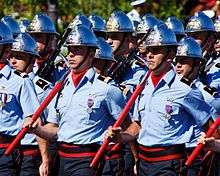

In Germany, even the smallest villages are required to have a volunteer fire department, called the "Freiwillige Feuerwehr", by law. Even the biggest German city, Berlin, with more than 3.6 million inhabitants, has volunteer firefighters in addition to a regular professional fire service. However, due to urbanization and a shrinking population, very small villages may be exempt from this requirement if the area can be covered by the fire department from a neighboring town. If this is not the case, a compulsory fire department is established by conscripting every able-bodied inhabitant between 18 and 63 years of age. A career fire service is mandatory for towns with more than 100,000 inhabitants. Consequently, only 103 German cities have a career fire service, called the "Berufsfeuerwehr", but in all of these cities a volunteer fire service exists too. In cities with a career fire service, volunteer fire brigades support the career fire service in the case of several emergencies at once, bigger fires, accidents and disasters. In a few of the bigger towns (usually more than 35,000 inhabitants) a large volunteer fire department could consist of a core of career firefighters supported by true volunteer firefighters. However, the official title of those departments is nevertheless "volunteer fire service".
The structure in Austria is similar to Germany. There are just six career fire services in Vienna, Graz, Innsbruck, Klagenfurt, Salzburg and Linz. As of 2007, some 4,527 volunteer fire departments, the back-bone of the Austrian fire service, could rely on about 320,000 men and women voluntary firefighters as active members.[18] Fire departments exist in even the smallest villages, where they contribute to community life, usually by organizing fairs and other fund-raising activities.
In Venezuela, there are, beside the types mentioned above, University Firefighters. They attend any emergency inside the campus and the zones around; however, their most important job is to develop new technologies in this area, thanks to the high level of education of its members: in the Simón Bolívar University Volunteer Fire Department, around 80% of its members have a university degree or are in the process of obtaining one.
In Japan, fire services are organized on a city/town/village basis. There are 894 fire headquarters and 3,598 volunteer fire corps. These have a total of 155,000 active career firefighters and 21,000 vehicles with 4,800 fire houses; 920,000 volunteer firefighters share an additional 51,000 trucks.
In Romania, the Romanian General Inspectorate for Emergency Situations is responsible for fire fighting and civil defense.
In Singapore, the Singapore Civil Defence Force is responsible for fire fighting and emergency response. In addition to career firefighters, there are conscripted firefighters, generally young adults between the ages of 18-25, that join under the national service scheme (see Conscription in Singapore).
In India municipalities are required by law to have a fire brigade and participate in a regional fire service. Each city has its own fire brigade. The main functions of firefighting services in India are provision of fire protection and of services during emergencies such as building collapses, drowning cases, gas leakage, oil spillage, road and rail accidents, bird and animal rescues, fallen trees, appropriate action during natural calamities, and so on. Industrial corporations also have their own firefighting service. Each airport and seaport has its own firefighting units.
Communication and command structure
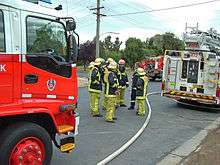
The expedient and accurate handling of fire alarms or calls are significant factors in the successful outcome of any incident. Fire department communications play a critical role in that successful outcome. Fire department communications include the methods by which the public can notify the communications center of an emergency, the methods by which the center can notify the proper fire fighting forces, and the methods by which information is exchanged at the scene. One method is to use a megaphone to communicate.
A telecommunicator (often referred to as a dispatcher) has a role different but just as important as other emergency personnel. The telecommunicator must process calls from unknown and unseen individuals, usually calling under stressful conditions. He/she must be able to obtain complete, reliable information from the caller and prioritize requests for assistance. It is the dispatcher's responsibility to bring order to chaos.
While some fire departments are large enough to utilize their own telecommunication dispatcher, most rural and small areas rely on a central dispatcher to provide handling of fire, rescue and police services.
Firefighters are trained to use communications equipment to receive alarms, give and receive commands, request assistance, and report on conditions. Since firefighters from different agencies routinely provide mutual aid to each other, and routinely operate at incidents where other emergency services are present, it is essential to have structures in place to establish a unified chain of command, and share information between agencies. The U.S. Federal Emergency Management Agency has established a National Incident Management System.[19] One component of this system is the Incident Command System.
All radio communication in the United States is under authorization from the Federal Communications Commission (FCC); as such, fire departments that operate radio equipment must have radio licenses from the FCC.
Ten codes were popular in the early days of radio equipment because of poor transmission and reception. Advances in modern radio technology have reduced the need for ten-codes and many departments have converted to simple English (clear text).
Ranks
Many firefighters are sworn officers with command structures similar to the military and police. They do not have general police powers (some firefighters in the United States have limited police powers, like fire police departments, while certain fire marshals have full police powers, i.e. the ability to make warantless arrests, and authority to carry a firearm on and off-duty), but have specific powers of enforcement and control in fire and emergency situations.
Canada
Ranks amongst Canadian firefighters vary across the country and ranking appears mostly with larger departments:
Toronto
| Rank | Insignia |
|---|---|
| Probationary Firefighter | no rank |
| Second Class Firefighter | no rank |
| First Class Firefighter | no rank |
| Captain | 2 silver epaulette stripes |
| District Chief | 2 gold stripes |
| Platoon Chief | 3 gold stripes |
| Division Commander | 3 thick and 1 thin gold stripes |
| Deputy Fire Chief | 4 gold stripes |
| Fire Chief | 5 gold stripes |
Montreal

| Rank | Insignia |
|---|---|
| Firefighter/Firefighter Instructor | no rank |
| Interim Lieutenant | 1 white stripes |
| Lieutenant/Lieutenant Instructor | 2 white stripes |
| Captain | 3 white stripes |
| Operations Chief | 1 thick yellow stripes |
| Division Chief | 1 thick and 1 thin yellow stripes |
| Assistant Chief | 1 thick and 2 thin yellow stripes |
| Deputy Chief | 1 thick and 3 thin yellow stripes |
| Fire Chief | 1 thick and 4 thin yellow stripes plus star |
Chile
Ranks are divided between Company Officers and Fire Department Officers, which can be subdivided between Active Officers (Field Officers) and Administrative Officers each. The active officers are the captain, and two or three lieutenants, these three active officers are distinguished by their red helmets.
Commonwealth
Most fire brigades in Commonwealth countries (except Canada) have a more "civilianised" nomenclature, structured in a traditional manner. For example, the common structure in United Kingdom brigades is:
| Rank | Collar/epaulette markings | Helmet colour/pattern | Form of address |
|---|---|---|---|
| Firefighter Trainee | Red | Yellow helmet, often with the Trainee's surname written across to allow trainers to identify them | None |
| Firefighter Development | None | Yellow helmet with a red diamond indicating the Firefighter is capable of responding to fire calls, but is in the final stage of his/her training | None |
| Firefighter | None | Yellow helmet with no marking indicates a "competent" (fully trained) firefighter. | None |
| Crew Manager | Two chrome bars on blue | Yellow helmet with two 12.5mm horizontal black stripes | Crew |
| Watch Manager | Two impellers on blue | White helmet with one 12.5mm horizontal black stripe | Watch |
| Station Manager | Three impellers on blue | White helmet with one 19mm horizontal black stripe | Sir/Ma'am |
| Group Manager | One impeller inside wreath on blue | White helmet with one 12.5mm and one 19mm horizontal black stripes | Sir/Ma'am |
| Area Manager | One chrome bar and one impeller inside wreath on blue | White helmet with two 19mm horizontal black stripes | Sir/Ma'am |
| Deputy Chief Fire Officer | One chrome bar, one impeller and one large impeller inside wreath on blue | White helmet with one 38mm horizontal black stripe | Sir/Ma'am |
| Chief Fire Officer | Two impellers and one large impeller inside wreath on blue | White helmet with one 38mm horizontal black stripe | Sir/Ma'am |
France
French civilian fire services, which historically are derived from French army sapper units, use standard French Army ranks. The highest rank in many departments is full Colonel.
Germany
In Germany every federal state has its own civil protection laws thus they have different rank systems. Additionally there is a difference between a rank and an official position. This is founded on the military traditions of the fire departments. Every firefighter can hold a high rank without having an official position. A firefighter can be promoted by years of service, training skills and qualifications. Official positions are partly elected or given by capabilities. These conditions allow that older ordinary firefighters have higher ranks than their leaders. But through this ranks are no authorities given (Brevet).
Italy
The Vigili del Fuoco, literally the Fire-watchers, (official name Corpo nazionale dei vigili del fuoco) (CNVVF, National Fire-watchers' Corps) is Italy's institutional agency for fire and rescue service. It is part of the Ministry of Interior's Department of Fire Watch, Public Rescue and Public Protection. The corps' task is to provide safety for people, animals and property, and to give technical assistance to industries and fire prevention advice. It also ensures public safety in terrorist emergencies such as chemical, bacteriological, radiological and nuclear attacks. Since 2012 the Corps uses its own rank titles (dating from 2007) with matching military styled insignia in honor of its origins.
| Directors general |
|---|
| Dirigente generale capo del corpo |
| Dirigente generale |
| Dirigente superiore |
| Primo dirigente |
| Directors |
| Direttore vice dirigente |
| Direttore |
| Vice direttore |
| Substitute Fire Directors |
| Sostituto direttore antincendi capo |
| Sostituto direttore antincendi |
| Fire inspectors |
| Ispettore antincendi esperto |
| Ispettore antincendi |
| Vice ispettore antincendi |
| Non-commissioned officers |
| Capo reparto esperto |
| Capo reparto |
| Capo squadra esperto |
| Capo squadra |
| Enlisted firefighters |
| Vigile coordinatore |
| Vigile esperto |
| Vigile qualificato |
| Vigile del fuoco |
| Volunteer firefighters |
| Funzionario tecnico antincendi |
| Capo reparto volontario |
| Capo squadra volontario |
| Vigile volontario |
Iran
In Iran, every province has its own firefighting department, but ranks are the same in the whole country, and are as follows:
| Rank | Persian | Collar/epaulette markings | Collar/epaulette markings (in Persian) |
|---|---|---|---|
| Volunteer Firefighter I | آتش نشان داوطلب سوم | One yellow bar | یک خط زرد |
| Volunteer Firefighter II | آتش نشان داوطلب دوم | Two yellow bars | دو خط زرد |
| Volunteer Firefighter III | آتش نشان داوطلب | Three yellow bars | سه خط زرد |
| Firefighter I | آتش نشان سوم | One silver bar | یک خط نقره ای |
| Firefighter II | آتش نشان دوم | Two silver bars | دو خط نقره ای |
| Firefighter III | آتش نشان | Three silver bars | سه خط نقره ای |
| Head Firefighter I | سرآتش نشان سوم | One flame and one gold bar | یک شعله و یک خط طلایی |
| Head Firefighter II | سرآتش نشان دوم | One flame and Two gold bars | یک شعله و دو خط طلایی |
| Head Firefighter III | سرآتش نشان | One flame and Three gold bars | یک شعله و سه خط طلایی |
| Master Firefighter I | آتش یار سوم | One flame | یک شعله |
| Master Firefighter II | آتش یار دوم | Two flames | دو شعله |
| Master Firefighter III | آتش یار | Three flames | سه شعله |
| Master Firefighter IV | سر آتش یار | Four flames | چهار شعله |
| Chief Firefighter I | آتش پاد سوم | One empty gold wreath | یک حلقه گل طلایی خالی |
| Chief Firefighter II | آتش پاد دوم | One gold wreath with a flame inside | یک حلقه گل طلایی با یک شعله درونش |
| Chief Firefighter III | آتش پاد | One gold wreath with a flame inside and a silver bar below them | یک حلقه گل طلایی با یک شعله درونش و یک خط نقره ای زیر آنها |
| Chief master Firefighter I | فرآتش پاد سوم | One gold wreath with a flame inside and two silver bars below them | یک حلقه گل طلایی با یک شعله درونش و دو خط نقره ای زیر آنها |
| Chief master Firefighter II | فرآتش پاد دوم | One gold wreath with a flame inside and three silver bars below them | یک حلقه گل طلایی با یک شعله درونش و سه خط نقره ای زیر آنها |
| Chief master Firefighter III | فر آتش پاد | One gold wreath with a flame inside and four silver bars below them | یک حلقه گل طلایی با یک شعله درونش و چهار خط نقره ای زیر آنها |
Ireland
In Ireland, the traditional brigade rank structure is still adopted. Below is the common structure for most brigades, Cork and Dublin Fire Brigade have additional ranks:
| Rank | Helmet colour/markings | ||
|---|---|---|---|
| Firefighter | Plain Yellow Helmet | Leading Firefighter/Driver Mechanic in retained brigades | Yellow Helmet with one 12.5mm horizontal black stripe |
| Sub Officer | Yellow Helmet with two 12mm black stripes | ||
| Station Officer | White helmet with one 19mm horizontal black stripe | ||
| Assistant Chief Fire Officer | |||
| Senior Assistant Chief Fire Officer | White helmet with one 38mm horizontal black stripe | ||
| Chief Fire Officer | White helmet with two 38mm horizontal black stripe |
Japan
Japanese Fire Department's rank insignias are place on a small badge and pinned above the right pocket. Rank is told by stripes and Hexagram stars. The design of the insignias came from older Japanese style military insignias. Officers and Team Leaders could wear an arm band on the arm of fire jacket to show status as command leader. Sometimes rank can be shown as different color fire jacket for command staff. The color whites and gray are reserved for EMS. Orange is reserved for rescuer.
Firefighter
|
Assistant Fire Sergeant
|
Fire Sergeant
|
Fire Lieutenant
|
Fire Captain
|
Battalion Chief
|
Assistant Chief
|
1st Assistant Chief
|
Deputy Chief
|
Fire Chief
|
New Zealand
In New Zealand, rank is shown on epulattes on firefighters' station uniform, and through colors and stripes on firefighter helmets. As the nation only has a single fire department, the New Zealand Fire Service, ranks are consistent through the country.
| Rank | Epaulette[20] | Helmet[20] |
|---|---|---|
| Trainee Firefighter (TFF) | plain | fluro-green |
| Firefighter (FF) | plain | yellow |
| Qualified Firefighter (QFF) | one bar | yellow, one red stripe |
| Senior Firefighter (SFF) | two bars | yellow, two red stripes |
| Station Officer (SO) | one impeller | red, one blue stripe |
| Senior Station Officer (SSO) | two impellers | red, two blue stripes |
| Deputy Chief Fire Officer (DCFO) | impeller between two ferns below one impeller | white, one blue stripe |
| Chief Fire Officer (CFO) | impeller between two ferns below two impellers | white, two blue stripes |
| Assistant Area Commander (AAC) | three impellers | silver |
| Area Commander (AC) | one impeller below a crown | silver, one blue stripe |
| Assistant National Commander (ANC) | three impellers trefoil below a crown | silver, two blue stripes |
| Deputy National Commander (DNC) | silver crossed sword and baton below an impeller | black |
| National Commander (NC) | silver crossed sword and baton below a crown | black |
Russian Federation

In the Russian Federation, the decals are applied symmetrically on both sides of the helmet (front and rear). The location of the decals on the special clothing and SCBA is established for each fire department of the same type within the territorial entity. The following ranks are used by State Fire Service civilian personnel, while military personnel use ranks similar to those of the Police of Russia, due to their pre-2001 history as the fire service of the Ministry of Internal Affairs of the Russian Federation before all firefighting services were transferred to the Ministry of Emergency Situations.

| Rank | Helmet colour/markings |
|---|---|
| Firefighter | The all color helmet with the applied number, indicating the fire station |
| Head of fire brigade | The all color helmet with the applied number, indicating the fire station, underlined by line 50 mm wide and 5 mm thick |
| Head of duty shift fire station | The all color helmet with the applied a circle, inside which the applied number is indicating the fire station |
| Deputy Head of the fire station | The all color helmet with the applied a triangle, inside which the applied number is indicating the fire station |
| Head of the fire station | The all color helmet with the applied a square, inside which the applied number is indicating the fire station |
| Commanding staff of the fire department | The all color helmet with the applied a circle, inside which the applied a rhombus |
United States of America
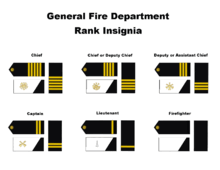
In the United States, helmet colors often denote a fire fighter's rank or position. In general, white helmets denote chief officers, while red helmets may denote company officers, but the specific meaning of a helmet's color or style varies from region to region and department to department. The rank of an officer in an American fire department is most commonly denoted by a number of speaking trumpets, a reference to a megaphone like device used in the early days of the fire service, although typically called "bugle" in today's parlance. Ranks proceed from one (lieutenant) to five (fire chief) bugles. Traditional ranks in American Fire Departments that exist but may not always be utilized in all cities or towns include:
Firefighter
|
Engineer/Technician/Sergeant
|
Lieutenant
|
Captain
|
Battalion Chief/District Chief
|
Division Chief or Assistant /Deputy Asst.
Chief/Commissioner
|
Deputy Chief/Commissioner
|
Chief/Commissioner
|
The basic American fire department unit is a small unit called a "company" (under a lieutenant or captain depending upon rank structure) which is equivalent to a Commonwealth "watch" (under a sub-officer). An American fire captain is thus often equivalent to a Commonwealth sub-officer, and an American fire lieutenant to a Commonwealth leading firefighter. In many fire departments in the U.S., the rank of captain or lieutenant are both used to denote the most junior fire officer at the company level. There is no state or federal rank structure for firefighters and each municipality or volunteer fire department creates and uses their own unique structure.
Still some other American Fire Departments such the FDNY use military rank insignia in addition or instead of the traditional bugles. Additionally, officers on truck companies have been known to use rank insignias shaped like axes for Lieutenants (1) and Captains (2).
Firefighter equipment
 Toronto firefighters prepare their equipment
Toronto firefighters prepare their equipment- A firefighter using a hydraulic cutter during a demonstration

A partial list of some equipment typically used by firefighters:
- Hand tools, such as
- Flat-head and pick-head axe
- Pike pole
- Halligan bar
- Flashlight
- Spanner wrench
- Circular ("K-12"), Cutters Edge, and/or chain saws
- Hydraulic rescue tools such as spreaders, cutters, and rams
- Personal protective equipment ("PPE") designed to withstand water and high temperatures, such as
- Bunker gear, including turnout jacket and pants
- Self-Contained Breathing Apparatus (SCBA)
- Helmet, face mask and/or visor; climbing helmets
- Safety boots, gloves, and Nomex and Carbon flash hoods
- Personal Alert Safety System (PASS) device
- Handheld radio, pager, or other communication devices
- Thermal imaging camera
- Gas Meter
History of fire brigades

Although people have fought fires since there have been valuable things to burn, the first instance of organized professionals combating structural fires occurred in Ancient Egypt. Likewise, fire fighters of the Roman Republic existed solely as privately organized and funded groups that operated more similarly to a business than a public service; however, during the Principate period Augustus revolutionized firefighting by calling for the creation of a fire guard that was trained, paid, and equipped by the state- the first truly public and professional firefighting service. Known as the Vigiles, they were organised into cohorts and also served as a night watch and city police force.
Today, fire and rescue remains a mix of paid, call, and volunteer responders, with some Fire and Rescue Services in the UK employing a combination of retained firefighters (who carry pagers to remain on-call while at home or at work) and a small number of unpaid volunteer firefighters- a practice common with other services.
Volunteer and Career Firefighters
The history of the fire service (in America) began with the first established volunteer fire company in New Amsterdam, now known as New York.[21] Fire companies were composed of citizens who volunteered their time to help protect the community. As time progressed and new towns popped up throughout the region there was a sharp increase in the number of volunteer departments. The first career fire department was not established in the United States until 1853 in Cincinnati, Ohio (Cincinnati Fire & EMS Department). Many large cities began establishing paid, full-time, staff in order to try facilitate greater fire-related call volume. St. Louis Fire Department followed Cincinnati four years later and became the second established career fire department in the country followed by other large cities like New York (FDNY). City fire departments draw their funding directly from city taxes and share the same budget as other public works like the police department and trash services. Aside from big city fire departments, many populated suburbs and towns have career fire departments. The primary difference between a municipality department and a City department is the funding. Municipal fire departments do not share their budget with any other service and are considered to be private entities within a jurisdiction. This means that they have their own taxes that feed into their budgeting needs. Another main difference is the structure of the department. City fire departments have the mayor at the top of the chain where as municipal departments have elected board officials who help maintain and run the department along with the chief officer staff.
Dogs
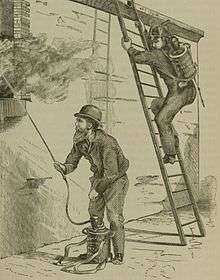

In popular literature firefighters are sometimes depicted with Dalmatian dogs. This breed originated in southern Europe and was primarily responsible for herding livestock and running alongside carriages drawn by horses. In the days of horse-drawn fire vehicles, the horses were usually released on arrival at the fire and the Dalmatians would lead the horses through traffic and to a safe place to wait until the fire was out. Dalmatians also filled the role of protecting the horses' feet from other dogs as equipment was being transported to the fire scene.
In reality, most fire dogs were mutts pulled from the street (and thus cheaper to acquire). In addition, Dalmatians have a reputation for skittishness and congenital defects, such as deafness and more violent tendencies due to inbreeding.
Fundraisers
Funds for fire-fighting equipment may be raised by the firefighters themselves, especially in the case of volunteer organizations. Events such as pancake breakfasts and chili feeds are common in the US. Social events are also used to raise money, including dances, community fairs and car washes.
Notable firefighters
- James Braidwood (firefighter) (1800–1861), founder of the municipal fire brigade in Edinburgh, 1824
- John Decker (1823–1892), chief of the New York City department during the 1863 draft riots
- Raúl Gándara-Cartagena (1895–1989), first and longest-serving Puerto Rico commonwealth fire chief
- James J. Kenney (1869–1918), Berkeley, California, politician, the city's first fire chief
- Louis R. Nowell (1915–2009), Los Angeles, California, City Council member, a firefighter for 23 years
- Chip Prather (born 1953), second chief of the Orange County, California, Fire Authority
- Joseph Pfeifer, New York City, New York, Chief of counterterrorism and emergency preparedness, was the first to make an official report of 9/11 and headed the operations at WTC
See also
- Code3D - training software for firefighters
- Fire apparatus (AKA Fire Engine or Truck)
- Fire services in Scotland
- Firefighting
- Firefighter arson
- History of firefighting
- Incident Command System
- Index of firefighting articles
- Rescue
- UK Ministry of Civil Aviation Aerodrome Fire Service
- Volunteer fire department
- Smokejumper
- Wildfire suppression
- Wildland Firefighter Foundation
- Women in firefighting
References
- ↑ ""firefighter" Merriam-Webster's Online Dictionary". Merriam-webster.com. 2012-08-31. Retrieved 2012-12-10.
- ↑ "America on the Move: Locomotive Engineer & Fireman". Americanhistory.si.edu. 2012-03-14. Retrieved 2012-12-10.
- ↑ "Retained Firefighters". Fire and Rescue NSW. September 17, 2011.
- ↑ "Fire Academy". Public Safety Elite. Retrieved 2016-03-10.
- ↑ Federal Highway Administration DOT 23CFR634 Worker Visibility
- ↑ "The New England Journal of Medicine",March 22, 2007, Accessed:July 17, 2011". Nejm.org. Retrieved 2012-12-10.
- ↑ "Hazardous waste operations and emergency response. - 1910.120". Osha.gov. Retrieved 2012-12-10.
- ↑ National Institute for Occupational Safety and Health Alert: Preventing Fire Fighter Fatalities Due to Heart Attacks and Other Sudden Cardiovascular Events. July 2007.
- ↑ [University of Illinois] https://www.fsi.illinois.edu/documents /research/CardioChemRisksModernFF_InterimReport2016.pdf
- ↑ Zephyr Technologies BioHarness BT
- ↑ "OSHA Technical Manual (OTM) - Section III: Chapter IV: Heat Stress". Osha.gov. Retrieved 2012-12-10.
- ↑ National Institute for Occupational Safety and Health Alert: Preventing Injuries and Deaths of Fire Fighters due to Structural Collapse. August 1999.
- ↑ National Institute for Occupational Safety and Health Alert: Preventing Injuries and Deaths of Fire Fighters Due to Truss System Failures. May 2005.
- ↑ Daniels, Robert D. (17 December 2014). "Is There a Link Between Firefighting and Cancer? – Epidemiology in Action". National Institute for Occupational Safety and Health. Retrieved 6 January 2015.
- ↑ "Study of Cancer among U.S. Fire Fighters". National Institute for Occupational Safety and Health. 25 July 2014. Retrieved 6 January 2015.
- ↑ Daniels RD, Bertke S, Dahm MM, Yiin JH, Kubale TL, Hales TR, Baris D, Zahm SH, Beaumont JJ, Waters KM, Pinkerton LE (2015). "Exposure-response relationships for select cancer and non-cancer health outcomes in a cohort of US firefighters from San Francisco, Chicago and Philadelphia (1950-2009)". Occupational and Environmental Medicine. doi:10.1136/oemed-2014-102671. PMID 25673342.
- 1 2 "Painting, firefighting, and shiftwork". IARC Monographs on the Evaluation of Carcinogenic Risks to Humans / World Health Organization, International Agency for Research on Cancer. 98: 9–764. 2010. PMID 21381544.
- ↑ Österreichischer Bundesfeuerwehrverband: Statistik des ÖBFV
- ↑
- 1 2 "Uniform rank markings". New Zealand Fire Service. Retrieved 10 January 2015.
- ↑ Essentials of Firefighting
External links
- Firehouse Drills from Fire Engineering Magazine
- Firefighter Careers
- Free fire training programs from Fire Engineering Magazine
- How to Become a Firefighter
| Wikimedia Commons has media related to Firefighter. |
| Look up firefighter in Wiktionary, the free dictionary. |
